NJ Teachers of English to Speakers of Other Languages/
NJ Bilingual Educators
ARTICLES SUMMER 2022
Getting Started with the Newcomer Tool Kit– Claudia Lagos
Message from Our New President
– Michelle Land and
Our New Vice-President– LeighAnn Matthews
Presidential Awards and Scholarships– Maggie Churchill
Behind the Scenes: Thank you!– Tina Kern
Conference Keynotes Focus on Linguistic Social Justice and Culturally Responsive Teaching– Kathleen Fernandez
Culturally and Linguistically Responsible Teaching– Kathleen Fernandez
Learning Through Examples: Inductive Learning– Dr. Annie Prud’homme-Généreux
PROOF POINTS: College Students Often Don’t Know When They’re Learning– Jill Barshay
How State Assessments Became and Remain a Drive for Equity for English Learners– Melissa Lazarin
10 Strategies That Support English Language Learners Across All Subjects–Joanna Schwartz
How to SEE Vocabulary in Reading and Writing– Leah Carmona
The Importance of Body Language for Effective Oral Communication and 5 Gestures to Teach MLLs– Judie Haynes
3 Ways To Activate Your Multilingual Students’ Superpowers– Teresa Krastel
Setting up Your Classroom to Foster a Language Learning Environment for MLs– Mindi Teich
Reaching Higher Heights with Scaffolds Workshop– with Esther Park
Upcoming Events and Professional Development for NJTESOL/NJBE in 2022-2023
Checking Reading Comprehension? Ask Better Questions!– Barbara Gottschalk
Levels Of Questions In Bloom’s Taxonomy–
Teacher Vision
A Look Back: 5 Instructional Strategies that Worked for My Classes This Year– Larry Ferlazzo
June 21, 2022
Getting Started with the Newcomer Tool Kit
By Claudia Lagos

The continuous rise of newcomers to classrooms across the country has left teachers, administrators, and districts scrambling for ways to support this growing population. Support systems vary within individual states and across the country. The U.S. Department of Education Newcomer Tool Kit is a great place to start when identifying steps in providing support for newcomers. The tool kit discusses topics such as identifying newcomers, welcoming newcomers, developing high-quality instruction for newcomers, how to support newcomers’ social-emotional needs and establishing partnerships with families.
Each school district may have a specific definition or usage of the word newcomer. However, the tool kit identifies newcomer as an umbrella term for eight types of migrant students. This feature is relevant as it can be helpful in identifying appropriate support and resources based on the type of newcomer needing services. For example, unaccompanied youth (children who came into the US without an adult) may benefit from having a counselor trained in separation trauma, whereas a student with limited or interrupted formal education (SLIFE) may benefit from a teacher trained in a phonics/reading program in a given language.
Furthermore, refugee newcomers may benefit from a district that promotes community events that build connections among refugees and local families. These are just a handful of examples of how properly identifying newcomers can be beneficial to the students and their families.

Another section (Chapter 2) in the tool kit shares strategies on how to welcome newcomers and their families. It suggests a number of resources that should be shared with families upon arrival. These resources include school schedules, a map of the school, and even creating invitations to school-wide events in each family’s native language. The chapter also highlights best practices in six key areas that ensure an opportunity for newcomers to thrive in their new school community. To ensure newcomer success, it is essential to learn as much about their background as possible. This includes the students’ former schooling experience, cultural and linguistic experiences, and current family needs and structures. This can be achieved through a student and family survey to create a learner’s profile for ongoing reference.
Chapter 4 is titled “How Do We Support Newcomers’ Social Emotional Needs?”. In this SEL-focused section, the tool kit discusses an overview of newcomer stressors, provides definitions for each category, and possible causes of stressors. The four main stressors presented are isolation, trauma, acculturation, and resettlement. Understanding the stressors newcomers face can guide teachers to choose the best teaching practice.
The chapter includes a list of 10 Teaching Practices for Social-Emotional Development. One practice is titled “Warmth and Support.” This practice involves the ‘academic and social support that students receive from their teacher and from their peers.’ Teachers can create a safe and engaging learning environment where students are encouraged to celebrate one another as modeled by the teacher. The practice also suggests teachers provide an environment for students to engage in academic and social dialog. Lastly, the teacher can establish a relationship where students understand that there are approachable adults within their school community who can support their particular needs.
Aside from the above-mentioned topics, the Newcomer Tool Kit contains many other suggestions for newcomer success. Newcomers truly are one of the most resilient populations in our schools. With the proper support system, newcomers can thrive in their schools and communities. They can also impact those that encounter them that hear and honor their stories.
Claudia Lagos is a Bilingual Teacher in the Morris School District.
June 28, 2022
Message from Our New President
My Fellow Members,
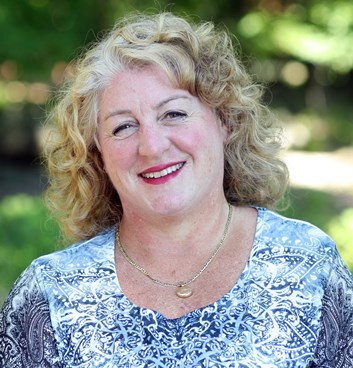
When I first became involved in NJTESOL/NJBE as a member over 15 years ago, I never could have imagined becoming President. I was just so thankful to have an organization that supported my students and me in ways that were sometimes hard for my co-workers to understand. It was like finding a long lost family – maybe you have felt the same way too?
As I became more involved, presenting at the spring conferences, representing NJTESOL/NJBE at the NJEA convention in Atlantic City, eventually becoming a SIG representative, Chapter Leader, and then Vice-President, I continued to be in awe of what our members, my fellow executive board members, and our chapters do for this organization.
Most of the executive board members are volunteers. Our chapter leaders are volunteers. They all give freely of their time and expertise to support our organization and its members.
Our organization is always evolving and yet, the heart of the organization is a constant.
Everyone works towards our mission of supporting “the development of bilingual education and the teaching of English as a Second Language” through a variety of ways.
If you attended our Spring 2022 Conference or participated in the Video library, you could easily see that our mission is thriving.
As your President, I will continue to support this mission while putting the organization, its needs and its interests first.
We will be sending out a survey to our members this summer to get YOUR input. Please look for it in your inbox.
I am honored and humbled to serve as your President. My inbox is always open to your suggestions, questions, and comments. Please feel free to contact me via email: president@njtesol-njbe.org or on Twitter: @LandinESL.
Thank you for allowing me to serve, Michelle Land,
President, NJTESOL/NJBE
Message from Our New Vice-President
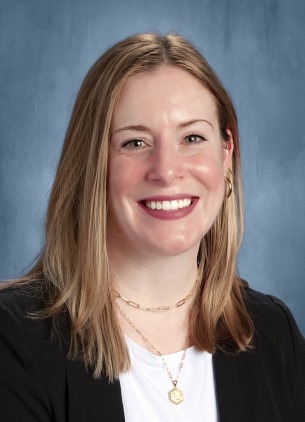
Thank you membership for entrusting me in this new role as vice president of NJTESOL/NJBE! I am so excited to work alongside our president, Michelle Land, and the executive board in this new way.
One of my favorite parts of being on the board is meeting and connecting with colleagues from across the state and beyond with different perspectives and ideas. I look forward to continuing to do that.
I am the former liaison (2019-2022) and Bilingual/ESL early childhood/preK-K SIG representative (2018-2019). When I am not working with the organization, I work full time as a K12 ESL Instructional Coach in Bridgewater Raritan Regional School District, a part time lecturer at Rutgers GSE, and I am pursuing both my principal and supervisor certifications through NJEXCEL.
My true passion lies in mentoring and/or coaching others so that they feel empowered to grow and be their best for our multilingual learners and families. I am fortunate that I get to do that every day in some form or another! In my spare time I enjoy designing and providing professional learning opportunities about advocacy, changing mindsets, and Sheltered Instruction. I have presented for NJTESOL/NJBE at the Spring Conference and chapter meeting, as well as NJPSA, NJASCD, NJEA, NJDOE, and TESOL.
When I think about my vision for the future of our organization, the word reimagine/reimaginar comes to mind. When we reimagine we often define, evaluate, explore, connect, listen, reflect, and sometimes even need to unlearn. It’s no secret that the Covid-19 pandemic forced the world to adjust to the new normal – virtual meetings, gathering restrictions, wearing masks, and more. It was pure survival mode.
We are entering a very unique time in education and in our field especially, where we are faced with taking what we went through, what our students and families went through, what was inequitable, what did not work, and using it to propel ourselves forward – reimagining.
As an organization it is also time to reimagine and move forward together.
Define our mission and vision;
NJTESOL/NJBE, Inc. is a not-for-profit professional and educational organization whose purposes are:
- To actively support the development of bilingual education and the teaching of English as a Second Language;
- To strengthen instruction at all levels;
- To disseminate educational information as related to professional development;
- To provide educational services such as workshops, conferences, and consulting assistance;
- To promote scholarship and foster research in first and second language acquisition and bilingual/bicultural studies; and
- To cooperate in appropriate ways with other groups having similar interests and concerns.
Then evaluate what we need to bring with us into this new school year and explore what we need to possibly unlearn. Listen to the voices of our members and reflect with each other as an executive board team. Connect intentionally and build relationships. All while keeping our multilingual learners and families in New Jersey as our “why”.
I am so thrilled to be serving in this role, reimagining, and I look forward to the future.
Please feel free to connect with me any time through my email
vice-president@njtesol-njbe.org or on Twitter: @theESLlady.
LeighAnn Matthews
Vice-President, NJTESOL/NJBE
July 5, 2022
Presidential Awards
By Maggie Churchill
The 2022 President’s Reception was the first in-person ceremony since 2019. It was an emotional experience to see everyone together, and also live on Zoom. Scholarships were awarded in ten categories, with this year increasing the number of recipients to seventeen awardees. The President’s awards were given in four categories:
The Dr. Elizabeth “BJ” Franks Advocacy Award was awarded jointly to the New Jersey Consortium for Immigrant Children and Education Law Center for the publication of the document, English Language Learners in New Jersey: Exposing Inequities and Expanding Opportunities in the Wake of the Pandemic (November 2021), for their work supporting the rights of English language learners by hosting a member webinar, and for making recommendations to the NJDOE on the revision of the New Jersey Bilingual Education Code.
The Fred Carrigg Leadership Award was awarded in memoriam to Ana Ester Perez Arrieta, who was the former Family Liaison coordinator at Brunswick Charter School in New Brunswick. The leadership award honors the work of Ms. Perez Arrieta in helping bilingual families receive essential services and access educational technology during the pandemic. Ms. Perez Arrieta’s influence continues to live on in the communities she has served.
The Seal of Biliteracy Superintendent of the Year was awarded to Sandra Montañez Diodonet, Superintendent of Passaic Public Schools. This award recognizes commitment to promoting achievement in biliteracy. During pandemic instruction in 2020, Passaic Public Schools awarded 116 high school students the New Jersey Seal of Biliteracy. Passaic Public Schools continues to be named a Model Bilingual Program by the New Jersey Department of Education.
The President’s Award is presented to Sharon Rosario, Program Specialist, NJ Department of Education, Bergen County Office of Education. The President’s Award honors Ms. Rosario’s longtime dedication to the equitable practices surrounding the teaching and learning of multilingual learners in New Jersey. Ms. Rosario created a resource package for administrators and supervisors who work with English language learners to prioritize the needs of ELLs within Bergen County.
It was an honor to host this event. I am already looking forward to next year’s reception!
Maggie Churchill is the Past-President of NJTESOL/NJBE.
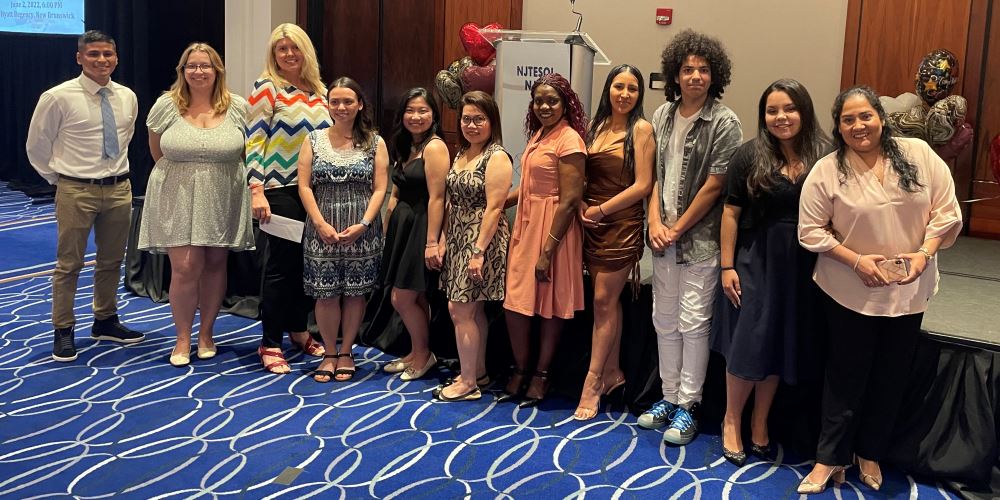
Scholarships and Awards
Fourth Grade Award
Aaron Chen & Wanderson Aracena-Perez
Eighth Grade Award
Udar Ceylan & Elizaveta Melchakova
Raquel Sinai Newcomer Scholarship
Ashley Andaluz & Yamilex Cruz
Pedro J. Rodriguez High School Scholarship
Luisa Martinez & Joselin Mejia
Higher Education Scholarship
Ariel Cavero Reyes & Fatoumata Diop
Seal of Biliteracy Scholarship
Fiorella Armebianchi Yancaya & Eloisa Eunice Mora
Praxedes Leon Seal of Biliteracy Parent Award
Fiorella Armebianchi Yancaya & Sally Mora
Dr. Jessie Reppy Graduate Student Scholarship
Sherylanne (Shan) Meisner
Bilingual Educator Scholarship
Jillian Bandel
Judie Haynes’ Grant for ESL/Bilingual Teachers Grant
Prudence Soobrattie
Scholarship and Award Winners’ Photos
July 12, 2022
Behind the Scenes: Thank you!
By Tina Kern
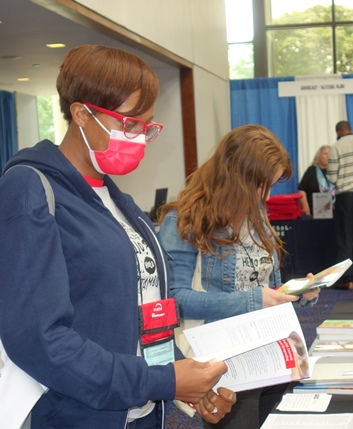
It was an incredible conference! We finally had a chance to experience the energy of fellow educators meeting – in person- to pursue our passion! We learned new ideas and shared information about ESL and Bilingual Education. We listened to keynotes, attended workshops, and let the atmosphere of pure excitement carry us forward to various rooms and corners of the Hyatt where we gathered resources, information, material, and technology, while we savored the wafting aroma of the buffet, and, of course, the chocolate cake.
Our NJTESOL/NJBE conference lasted three days and we valued the time we spent there, but in what seemed like just a few seconds, it was over. The memories remained, but as the attendees left and the booths were broken down, the hotel morphed back into a blank slate where once our booths, signs, and registration desk resided.
Most people don’t realize that the conference is actually a culmination of months and months – and months – of planning, meetings, emails, calls, and more meetings that conclude in a frenetic three days. What seems to some like a seamless series of workshops, keynotes, buffets, and activities is actually a long process of sometimes nail-biting, sleepless days and nights waiting for the right pieces to fall into place so that we can bring everyone a superior event that is worthy of our organization and our members. Behind the scenes are a group of individuals that come together as a gigantic force, pooling their expertise, and giving their time and energy together to create this conference.
The conference is a tour de force, with so many working parts. Today I want to highlight a group and also thank them for helping to make our conference a success. They support us in many ways and also add to the energy pulsing through the atmosphere. They bring us information, materials, and technology that help us elevate the level of our lessons, provide ideas, and promote innovation. I want to thank our sponsors and exhibitors for once again attending our conference, and adding their enthusiasm. Our sponsors give of their time and energy, too, as well as purchase prime locations for their booths which transfer to helping to support our conference by their attendance. We acknowledge the importance of sponsors and the confidence they show in us, in our organization, NJTESOL/NJBE, by their loyalty year after year.
Even though we are looking forward to a respite from the classrooms for a short time, soon we will again don our hats as teachers, and begin to reconstruct our classrooms with a welcoming atmosphere including a plethora of posters, charts, books, and other motivating material. At this time, please take a moment to reflect upon the wonderful resources you saw at the conference, encompassing so many grades and levels, but with our students at the center of all that our exhibitors bought for us to peruse. Remembering our sponsors by considering their material and revisiting their websites, looking at their selections, technology, information, and all they offer, is a reaffirmation of one of the purposes of our conference. We thank our sponsors for all that they do to contribute to our success! We thank our sponsors for all that they do to contribute to our success!
See below for the links to the photo galleries.
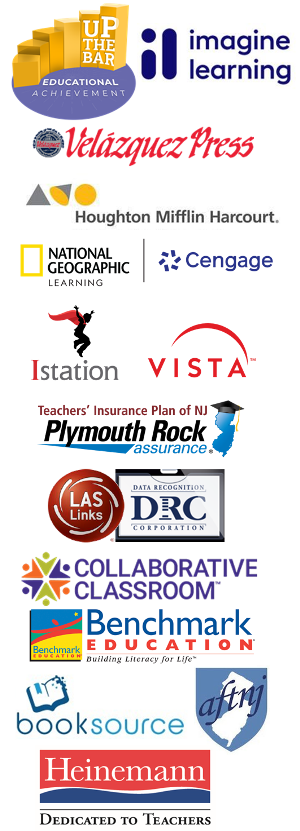 Our 2022 Conference Sponsors
Our 2022 Conference Sponsors
We thank our Diamond Sponsors:
Imagine Learning
Up the Bar Educational Achievement
Velazquez Press
We thank our Platinum Sponsors:
Houghton Mifflin Harcourt
National Geographic Learning/Cengage
We thank our Gold Sponsors:
Data Recognition Corporation
Istation
Vista Higher Learning
Teachers’ Insurance Plan of NJ
We thank our Silver Sponsors:
American Federation of Teachers/NJ
Benchmark Education
Booksource
Collaborative Classroom/Crabtree Publishing/Mindplay
Heinemann Publishing
Behind the Scenes: Thank you! (cont.)
When you need a new idea or resource, think of the many sponsors and exhibitors that filled our Atrium and Main Exhibitor Hall. The representatives of these companies are ready to help you and show you examples of what they can do to “spice up” your lessons and differentiate skills for ELLs. If you need names of representatives, please reach out to me and I can help you connect with people from the companies that helped sponsor us, and those that exhibited at our conference.
In our field of teaching, we help each other and offer advice and assistance for the advancement of the education of our students. We have a conference to share with our colleagues. Contacting our sponsors is another way to gather information and resources, while at the same time saying “thank you” to another group of people who support us and applaud our organization and the students we represent.
Please contact me at exhibitor-liaison@njtesol-njbe.org for more information about materials and technology from our sponsors and exhibitors.
Tina Kern is the NJTESOL/NJBE Liaison for the Spring conference sponsors and exhibitors.
Spring Conference Photo Gallery
July 19, 2022
Conference Keynotes Focus on Linguistic Social Justice and Culturally Responsive Teaching
By Kathleen Fernandez

As we continue to focus on culturally responsive teaching, here are thoughts on the work of two of NJTESOL/NJBE’s Spring Conference Keynote speakers who focused on de-centering whiteness and countering anti-Blackness. Dr. Baker-Bell and Dr. Gerald provided socio-linguistic information/strategies about language teaching that is applicable to English language teaching on a broad scale. Their work is a next step in the work of Paulo Freire, discussing language and power, relates to Krashen’s affective filter theory, and connects directly to an asset based learning approach.
Recognizing Black language as a distinct language puts it on the same level as any other world language, with a vocabulary and grammar all its own; this scholarly research began before the 1960’s. Theories regarding incorporating Black language into the classroom mirror those of second language acquisition and the issues involved are also similar. Recognizing “language that triggers racial stereotypes and other negative associations without the stigma of explicit racism” (Bryan & Gerald, 2021) and the “veiled language to foster anxiety among certain audiences and to dehumanize people and communities of color” (Bryan & Gerald, 2021) is essential to protect our students and colleagues from harm and create a positive learning environment.

Dr. Gerald’s work on decentering whiteness is critical to our work as language teachers in New Jersey. As an ESL teacher of both children and adults for many years in predominantly white school districts, it was rare that the students in my classroom were white. These students spent their days unrecognized for the value of their language and culture, instead being told to acculturate into white mainstream culture and abandon their personal selves.
Decentering whiteness in the classroom leads to personal linguistic power and English success by recognizing that white mainstream English is a social construct created through political and academic control, not a superior form of language. This goes straight to engaging and alleviating some of the motivation, self-confidence, and anxiety issues related to lowering the affective filter according to Krashen. It also frees educators to recognize an asset based perspective for all second language students by looking at mainstream English as an artificial standard to be learned for a specific goal (the language of “success”), not because it is inherently better.
NJTESOL/NJBE’s hope was that educators of all multilingual learners would see again, as we recognized when I began teaching many years ago, that the power of students’ home languages, including Black English, is something to be celebrated and leveraged into more powerful language teaching today. To keep in mind when we are teaching that language is not binary, that accents and different versions of English are not “wrong” and that there is no “right” English, just a standard form that is required specifically for academic success.
Kathleen Fernandez is the Executive Director of NJTESOL/NJBE.
July 26, 2022
Culturally and Linguistically Responsible Teaching
By Kathleen Fernandez

Recently, my sister-in-law gave me a tour of her beautiful garden. It was full of a variety of flowers and plants encompassing all sizes, varieties, and colors and she had worked diligently to assure that each one had what it needed to grow. Our students are the same, a beautiful variety with individual needs to enable them to grow in their own way. Being culturally and linguistically responsible in our teaching requires us to be responsive to these needs and to recognize the cultural conditions in which they would flourish.
Like a guide to growing, there are articles which assist teachers in modifying their teaching to enable their students to flourish. “Culturally and Linguistically Responsive Teaching in our Classrooms” by Dr. Angello Villarreal in the NJEA Review provides touchpoints for creating a classroom that celebrates student diversity. Pointing out that cultural and personal backgrounds of the students and their larger community regarding education and social mores can lead to confusion about the importance of education and showing respect. Creating a safe environment and recognizing every student’s diversity through culturally responsive content and lesson choices leads to positive student success and experiences. This is a great piece to share with mainstream teachers working with multilingual students.
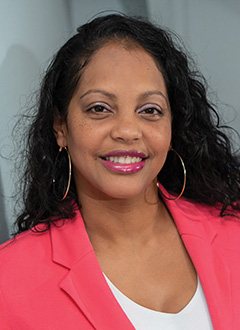
Lorena Germán, an English learner herself, reveals the importance of the social justice aspect of the topic in “The ‘Beautiful Struggle’ of Culturally Responsive Teaching”. She discusses her own educational past when “Some teachers did not really respect me or my peers—they didn’t believe that we really could engage in legitimately critical and thoughtful conversations.” Germán is an immigrant from the Dominican Republic who grew up in the U.S. and is now a middle school teacher.
She has written a book Textured Teaching: A Framework for Culturally Sustaining Practices which proposes four principles for classroom engagement: flexibility, interdisciplinary design, experiential learning, and a student-driven and community-centered approach. In this interview with Hoa P Nguyen of Edutopia, Germán discusses the difficulties but ultimately the importance of culturally responsive teaching for the wellbeing of all students and the significance of “gray space” where there may be discomfort and struggle in the search for common understanding.
Kathleen Fernandez is the Executive Director of NJTESOL/NJBE.
August 2, 2022
Learning Through Examples: Inductive Learning
By Dr. Annie Prud’homme-Généreux
 In this brief article, the author explains how to use examples to facilitate inductive learning, which leads to students being better able to apply the concepts in their own work.
In this brief article, the author explains how to use examples to facilitate inductive learning, which leads to students being better able to apply the concepts in their own work.
After describing direct teaching, from principle to examples, she offers an example of an inductive learning lesson. While this is from a college course, it could apply to any lesson.
She then delineates the steps of what to use and how to set up the inductive lesson. This includes two to five examples in which the key features are similar, but the contexts are different. She also recommends using examples that do not have the key features so students learn the differences. Finally, she mentions the guidance that the teacher needs to provide to facilitate learning.
Dr. Prud’homme-Généreux acknowledges that, “Implementing an inductive learning activity takes a bit more time than transmitting knowledge to learners, but the rewards are worth the investment: richer understanding, longer retention, greater ability to transfer knowledge to new situations, and an increased self-confidence in learners’ ability to think.”
You can find the details here.
PROOF POINTS: College Students Often Don’t Know When They’re Learning
By Jill Barshay
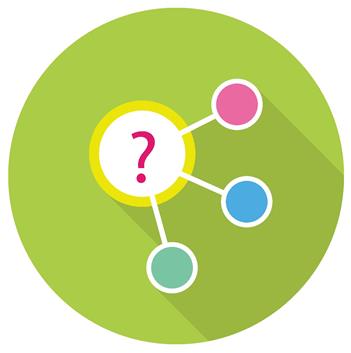 Jill Barshay, a writer for the Hechinger Report, described an experiment conducted by two professors teaching the same science course at Harvard.
Jill Barshay, a writer for the Hechinger Report, described an experiment conducted by two professors teaching the same science course at Harvard.
In their experiment, the professors taught the same concept, one giving the traditional lecture, and the other having his students solve problems about the same concept. Then they switched procedures for a second topic. After each of the lessons, the students filled out a survey about how much they felt they had learned. They also took a test to measure how much of the content they retained.
The results were the same for both teachers. Students felt that they had learned more from the lecture, but when they had to solve problems derived from the concepts, they performed better on the tests.
The author concluded that while we may enjoy a good lecture, and lectures are appropriate in some situations, learning from doing, while more difficult, produces better results.
You can find out more about the experiment here.
August 9, 2022
How State Assessments Became and Remain a Drive for Equity for English Learners
By Melissa Lazarin
 This article by Melissa Lazarin gives a historical view on state assessments for English learners. In the past, English learners were excluded from state testing, so data about their status and progress was minimal. While some districts began testing in the 1970’s, it wasn’t until 1994 that testing of all students was required. That requirement was tightened under No Child Left Behind so that 95% of students and all major groups of students had to be tested.
This article by Melissa Lazarin gives a historical view on state assessments for English learners. In the past, English learners were excluded from state testing, so data about their status and progress was minimal. While some districts began testing in the 1970’s, it wasn’t until 1994 that testing of all students was required. That requirement was tightened under No Child Left Behind so that 95% of students and all major groups of students had to be tested.
She warns that simplifying tests or not testing at all could result in a loss of services for English learners. In addition, she acknowledges that while these assessments are definitely not perfect, they keep a spotlight on English learners. The hope is that the data from these assessments will push states to require more support for English learners.
Lazarin concludes,
State assessment data, which are the only academic data that are widely available to community stakeholders and policymakers, will be critical to determining whether ELs are on the right trajectory to recover from the effects of the pandemic and remote learning. Not long ago ELs were invisible in this data, and therefore often overlooked altogether. The pandemic has underscored that, together with certain nonacademic data, state assessment data serve as a powerful tool to drive equity for ELs.
Contributed by Hana Prashker, NJTESOL/NJBE Liaison
Here are the details and links to more research.
10 Strategies That Support English Language Learners Across All Subjects
Teachers of any subject can use these tips to help English language learners be more engaged and at ease in class.
By Joanna Schwartz
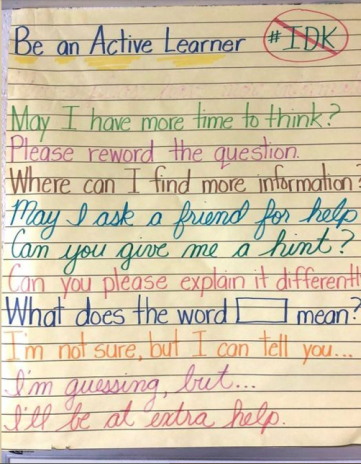 The author lists ten strategies that classroom teachers can use to help multilingual learners. Some are easy to implement, while the usefulness of others may depend on the students, their degree of English fluency, and their age. Many of these have links to charts and explanations.
The author lists ten strategies that classroom teachers can use to help multilingual learners. Some are easy to implement, while the usefulness of others may depend on the students, their degree of English fluency, and their age. Many of these have links to charts and explanations.
- Closed captioning
- Voice typing and Google Translate
- Chart of responses to questions
- Gestures
- Drawing or writing key words
- A chart with images of needs: water bottle, pencil, bathroom
- Pictures and the use of a document camera
- Pairing a newcomer with a bilingual student
- Notebook-like a picture dictionary of the subjects being taught
- If the teacher is wearing a mask, then a microphone and posters of mouth formations for English sounds
Swartz asks teachers to “Think about trying these strategies to help alleviate the communication difficulties that can prevent ELL students from becoming fully engaged in their learning and sharing who they are and what they can bring to the classroom.”
You can see more charts and suggestions here.
August 16, 2022
How to SEE Vocabulary in Reading and Writing
By Leah Carmona
 In this article, Leah Carmona describes how she uses word studies to not only build vocabulary and syntax, but also apply these to reading comprehension and writing.
In this article, Leah Carmona describes how she uses word studies to not only build vocabulary and syntax, but also apply these to reading comprehension and writing.
She describes how the knowledge of synonyms in an in-depth study of a vocabulary word as it is used in the context of a passage can lead to paragraph development in essay writing. Students can use the vocabulary that they have studied to apply the S.E.E. (See, Explain, Example) principle to build ideas for a paragraph. She adds that when students look for this principle in their reading, it can help them understand new vocabulary.
Carmona concludes:
“Speaking naturally and confidently is a goal all second language learning students aspire to; therefore, introducing learning strategies such as a flash card/word study and the SEE rule/chart, can help students improve their vocabulary, have more control of the language and organize their ideas easily not only in the classroom but also in their everyday activities.”
Here is the link for the details.
Websites for Collocations
 There are a number of different online resources that can help students recognize and use collocations, words that often appear together.
There are a number of different online resources that can help students recognize and use collocations, words that often appear together.
On Ozdic, students can look up a word and get an extensive list of words that can be used with other words, in what situations, how their word is used in each part of speech.
A website with grammar, reading, and vocabulary, English Club has sets of online collocation games. They also have a study of the vocabulary of censorship, a start for conversation and writing for older students. (Note: Some of the other word lists might not be appropriate for in-class use.)
This page on 7 ESL.com links to a lot of useful lists of collocations.
Thesaurus.com not only lists synonyms, but below that, if the student enters a sample sentence, they can see how the listed synonyms are used with their sentence. Below that are explanations and related words.
The Cambridge Learner’s Dictionary has relatively easy to understand definitions and very good examples of words in sentences that provide collocations.
The Oxford Learner’s Dictionaries also have easy definitions with a lot of examples that provide collocations with the bonus of an app, the Oxford Collocations Dictionary app.
The Longman Dictionary of Contemporary English Online defines words with conversational vocabulary, examples, and collocations for many words.
August 23, 2022
The Importance of Body Language for Effective Oral Communication
By Judie Haynes
 In her June and July blogs for TESOL, Judie Haynes wrote about helping multilingual learners (MLLs) understand how body language affects communication in U.S. culture. She also gives teachers of MLLs ideas for how to teach these concepts.
In her June and July blogs for TESOL, Judie Haynes wrote about helping multilingual learners (MLLs) understand how body language affects communication in U.S. culture. She also gives teachers of MLLs ideas for how to teach these concepts.
These are the three she described in the June blog.
- Eye Contact – In many cultures it is rude to look in someone’s eyes during a conversation. However, MLLs need to be taught that eye contact is expected in the United States. They need some practice doing it, so they are not misunderstood.
- Proxemics – The author describes the “American Bubble,” about 12-15 inches for each person, so two adults talking would be about double that distance from each other.
- Voice has three aspects:
- Volume – children have to be taught to use an inside voice in the appropriate situation, but MLLs who are unsure of their speaking skills in English, may speak too quietly.
- Pitch – This usually conveys feelings. This can be taught using pictures of different emotions.
- Intonation – In conversation, intonation indicates a question or a statement. Role-playing is suggested for practice with this.
The importance of learning about body language is to help students avoid confusion and embarrassment, and help teachers better understand their students.
You can read the details and comments here.
5 Gestures to Teach MLLs
 In the July TESOL blog, Judie Haynes wrote about five gestures that are commonly used in the United States.
In the July TESOL blog, Judie Haynes wrote about five gestures that are commonly used in the United States.
- “Come here.” This uses the index finger, but it is insulting in many other countries where all of the fingers or the whole hand is involved in the gesture.
- Thumbs up is obscene in a number of countries. These days, it also has other meanings if you search it online.
- Pointing at a thing is okay in the United States, but it is rude to point at a person, especially if it is accompanied by a mean remark about their appearance.
- Smiling at people doesn’t carry the same meaning around the world. In some cultures, people only smile at their friends, while in other cultures, smiling may indicate embarrassment.
- The okay gesture has different meanings around the world, and in some places, this too is obscene.
Judie Haynes was president of NJTESOL/NJBE 2010-2012, and she writes monthly blogs for TESOL International Association.
August 30, 2022
3 Ways To Activate Your Multilingual Students’ Superpowers
By Teresa Krastel
 Teresa Krastel writes that multilingual learners “are often defined only by the languages they speak—or don’t speak—and not by the myriad assets they bring.” They have greater ability to perform multiple tasks, more language for communication, higher cognitive skills and stronger social-emotional learning. She lists three ways to leverage those assets in the classroom.
Teresa Krastel writes that multilingual learners “are often defined only by the languages they speak—or don’t speak—and not by the myriad assets they bring.” They have greater ability to perform multiple tasks, more language for communication, higher cognitive skills and stronger social-emotional learning. She lists three ways to leverage those assets in the classroom.
The first strategy mentioned is to create a multilingual classroom space. She advises reflecting students’ cultures through posters, art, books, and students’ work in addition to deeper aspects of the students’ cultures such as the concept of time.
Second, she recommends encouraging translanguaging in informal classroom communication and through the use of the internet for research and translation.
Finally, Krastel suggests that teachers learn about their students’ cultures to “empower” students and foster their language learning. She also mentions using language games and reading for fun.
You can read about all of her ideas and links to other articles as well.
Article shared on Twitter by LeighAnn Matthews, NJTESOL/NJBE Vice-President
Setting up Your Classroom to Foster a Language Learning Environment for MLs
By Mindi Teich
 Although teachers may be limited in what they can do in arranging their classrooms, Mindi Teich encourages teachers to set up their classrooms so that students will have “multiple opportunities during the school day to interact with peers and teachers, both informally and for more structured academic purposes.”
Although teachers may be limited in what they can do in arranging their classrooms, Mindi Teich encourages teachers to set up their classrooms so that students will have “multiple opportunities during the school day to interact with peers and teachers, both informally and for more structured academic purposes.”
She states that students get the first impression of the classroom from the arrangement of the furniture. If possible, it should allow students to feel comfortable interacting and working in small groups
The second consideration is wall-space. She suggests working with students to create charts and scaffolds in both English and the students’ languages, and over time, removing outdated materials, leaving some accessible to students who might still need them.
A third option that can make a difference is labeling instructional materials and providing sentence starters that can be added to or changed, encouraging MLs to decide what they need.
You can read more and download the classroom checklist here.
September 6, 2022
Reaching Higher Heights with Scaffolds Workshop
With Esther Park
 All learners are capable of reaching higher heights with the right scaffolds and supports. In this session, you will learn about designing an equitable learning environment that meets the needs of all learners. Come learn about various digital and instructional scaffolds, engagement strategies, gamification ideas, and tech tools to help students use the four language domains (read, write, speaking, listen) and retain content! You will walk out of this session with ready-to-go templates and resources to use right away in your own classroom.
All learners are capable of reaching higher heights with the right scaffolds and supports. In this session, you will learn about designing an equitable learning environment that meets the needs of all learners. Come learn about various digital and instructional scaffolds, engagement strategies, gamification ideas, and tech tools to help students use the four language domains (read, write, speaking, listen) and retain content! You will walk out of this session with ready-to-go templates and resources to use right away in your own classroom.
Esther Park is a former high school ELA-ESL teacher of 15 years, a current adjunct instructor training future teachers of English language learners, and an instructional designer creating innovative learning experiences for K-12 and adult learners. Esther’s passion is to empower all learners to reach their full potential by developing technology-enhanced learning pathways that combine literacy and active learning techniques. Esther earned her B.A. in Psychology and Social Behavior from the University of California Irvine and an M.A. in TESOL (Teaching English to Speakers of Other Languages) from Biola University.
Co-sponsored with FLENJ.
Virtual Live and/or Recorded session – November 17th 4 PM to 6 PM
- The Virtual Live Zoom session will be from 4 PM to 6 PM on November 17th.
- Access to the RECORDED session will be available after November 17th.
Attending this workshop is only $30 for NJTESOL/NJBE members and $49 for non-members.
Upcoming Events and
Professional Development for NJTESOL/NJBE in 2022-2023
By Kathleen Fernandez
 Even as a retired teacher, September feels like the beginning of the year. The Executive Board of NJTESOL/NJBE wishes our teachers, professors, paraprofessionals, administrators, and all other educators who support multilingual learners in the classroom a wonderful new school year! We are busy planning our 2022-2023 events to support all of you in your missions. Here are just a few that will be announced soon:
Even as a retired teacher, September feels like the beginning of the year. The Executive Board of NJTESOL/NJBE wishes our teachers, professors, paraprofessionals, administrators, and all other educators who support multilingual learners in the classroom a wonderful new school year! We are busy planning our 2022-2023 events to support all of you in your missions. Here are just a few that will be announced soon:
- A return of Looking and Learning About the 2020 WIDA Standards Framework. This will be a condensed version of the 4 PLC sessions that we did last year
- A new PLC on the 2020 WIDA Standards Framework focused on practicing and application. Building on the foundation of the Looking and Learning PLC, these sessions will advance understanding of how to use the standards in the classroom.
- An Advocacy Committee Webinar, November 16, 2022 at 4:30. This year brings the revision of the Bilingual Education Code and there are always issues related to multilingual learners that require our attention. Learn how to advocate and what the NJTESOL/NJBE Advocacy Committee has been doing to support our members and their students.
- The Parent Expo will be virtual again this year in January 2023. This will be our 3rd year and we are excited to build our collection of videos to support parents. Videos from past sessions are available for use on the NJTESOL/NJBE Parent Resources page.
- A repeat of last year’s Federal Anti-Discrimination Laws that Protect English Learners’ Rights Webinar with our collaborators the Education Law Center and the Education Civil Rights Unit of the US Department of Justice.
- Professional development focused on Bilingual Educators and programs. We are looking for suggestions on areas of PD needs.
- Finally, we ask if you haven’t responded to our Professional Development survey, we ask that you do so now. Our goal is to support your needs in the classroom, campus, or wherever you educate New Jersey’s multilingual learners. NJTESOL/NJBE Membership PD Survey
Don’t forget our 2023 Spring Conference on May 23, 24, & 25, 2023! We will be in person again and there will be a video library of presentations as well. Registration for this amazing conference will be out soon. Best of luck and success to all our members and their communities in the 2022-2023 academic year!
Kathleen Fernandez is the NJTESOL/NJBE Executive Director.
September 13, 2022
Checking Reading Comprehension? Ask Better Questions!
By Barbara Gottschalk
 Barbara Gottschalk notes two different types of questions for reading comprehension. First, there are what she calls display questions, ones for which the teacher knows the answer, and second, referential questions, for which the teacher does not know the answer.
Barbara Gottschalk notes two different types of questions for reading comprehension. First, there are what she calls display questions, ones for which the teacher knows the answer, and second, referential questions, for which the teacher does not know the answer.
She claims that display questions are not good assessments of reading comprehension and recommends that they be reserved for quizzes or possibly small groups. Referential questions, on the other hand, generate discussion, “real communication” and speaking practice in the classroom.
This is one of Gottschalk’s examples:
Display Question: “What does frustrate mean?”
Referential Question: “What is something that frustrates you? Why? (requires the student to use the target vocabulary word in the open-ended response)”
You can check examples of all five different types of questions here.
Levels Of Questions In Bloom’s Taxonomy
Created by: TeacherVision Staff
 The authors explain how to use Bloom’s Taxonomy to ask higher-order questions. They propose that all levels of questions can be asked of students of any age. This can raise their level of thinking so that they learn as opposed to just preparing to be tested on what they remember.
The authors explain how to use Bloom’s Taxonomy to ask higher-order questions. They propose that all levels of questions can be asked of students of any age. This can raise their level of thinking so that they learn as opposed to just preparing to be tested on what they remember.
The article goes through the taxonomy with sample questions for each level.
Here are some of them:
Application:
“How would you use your knowledge of latitude and longitude to locate Greenland?”
“What happens when you multiply each of these numbers by nine?”
Analysis:
“What are some of the factors that cause rust?”
“Why do we call all these animals mammals?”
Synthesis:
“How would your life be different if you could breathe underwater?”
“Put these words together to form a complete sentence.”
Evaluation:
“What story did you like the best?”
“Why do you think Benjamin Franklin is so famous?”
They conclude that, “…students tend to read and think based on the types of questions they anticipate receiving from the teacher.” If the teacher asks questions that call for higher-level thinking, then the students will use higher-level thinking as they encounter new topics.
See the article and other resources linked from it.
September 20, 2022
Resources for Teaching
 If you are looking for resources, Larry Ferlazzo’s blogs offer a rich variety of links for teachers of multilingual learners. One of these is a midyear and annual best list. Scrolling down, you can find the most recent lists from 2021 and 2022.
If you are looking for resources, Larry Ferlazzo’s blogs offer a rich variety of links for teachers of multilingual learners. One of these is a midyear and annual best list. Scrolling down, you can find the most recent lists from 2021 and 2022.
In the 2021 list, you can find website lists, games, videos, posts, and more.
His My Best Posts on New Research Studies in 2021, contain summaries of articles he has read, and he often includes his experience in teaching in his comments. For instance, in his summary on an article about phonics, he agrees with the author that it has to be systematic, but Ferlazzo adds that it should not be drill and kill.
In a summary about data, Another Reason to be Careful about Being “Data Driven” he comments that the problem with data is that it doesn’t usually change teaching strategies.
A third posting out of many, titled We Teachers Should Try to Avoid “Toxic Positivity” this Fall, combines a few different studies. Ferlazzo acknowledges the benefits of being positive, but also relates how it is important to admit to having negative feelings as well.
If you have a little time, you may want to check some of these articles.
A Look Back: 5 Instructional Strategies that Worked for My Classes This Year
Larry Ferlazzo is a teacher and a prolific writer. Alongside his blog pages are also his own recent posts.
 Two weeks ago he re-posted this article about strategies that worked for him in the past year.
Two weeks ago he re-posted this article about strategies that worked for him in the past year.
- Using hard-copy textbooks and paper-based activities: Some students learn better from printed materials.
- Teaching key words before attempting reading passages: He had his students create slideshows of the words and teach them to their classmates.
- Using peer tutors: Some of the tutors are former ML’s who are proficient in English.
- Ending his classes with a little online game: This serves as a review and a formative assessment.
- Having his students fill out a brief Google form: This informs him of how they are doing and feeling and alerts him to his students’ needs.
You can find many more strategies in previous and linked posts.

